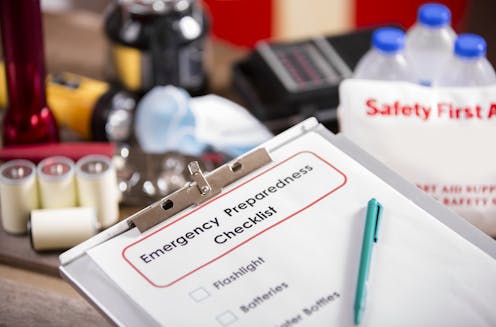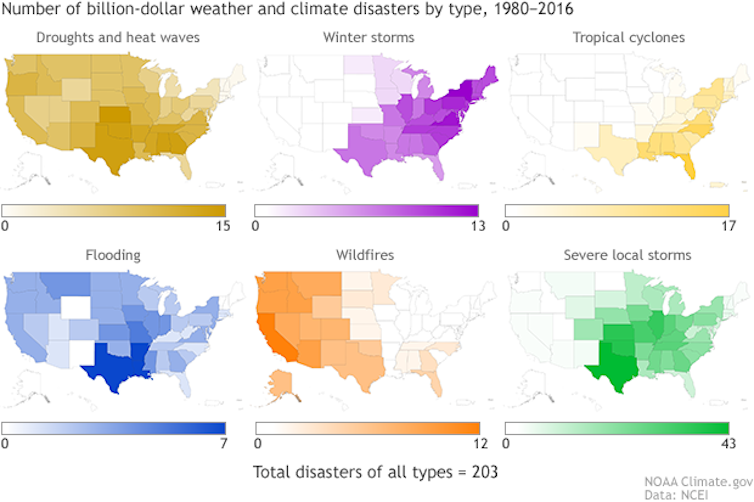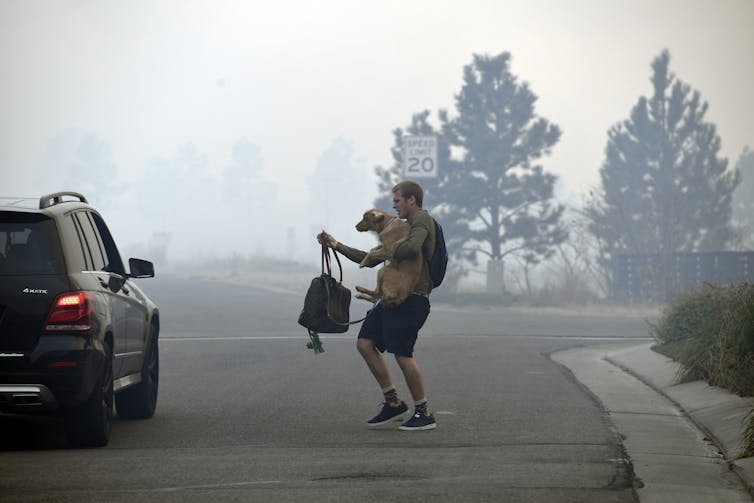What goes into a disaster kit and go-bag? Here's a checklist for everything from hurricanes to wildfires and other storms
- Written by Brett Robertson, Assistant Professor of Communication, University of South Carolina
 Disasters can happen anywhere at any time. Be prepared.fstop123 via Getty Images
Disasters can happen anywhere at any time. Be prepared.fstop123 via Getty ImagesWhen disasters hit, they can mean days to weeks without power, and sometimes they allow just enough time to grab a bag of supplies and go. Now is the time to prepare, well before the disaster is on your doorstep.
I study ways to improve disaster communications. Here’s what you need to think about.
Know your area’s disaster risk
While some hazards, like windstorms, happen in every region, certain disasters are more common in specific geographic areas. It’s important to know your risks.
The American Red Cross has a tool for determining common disasters in your area, like hurricanes along the Gulf and Atlantic Coasts from June through November, and wildfire season in the West, that seems to last all year now but worsens as winds pick up in late summer and fall. Each hazard requires different preparation steps.
 States with the most disasters that caused over US$1 billion dollars in damage, by disaster type.Climate.gov
States with the most disasters that caused over US$1 billion dollars in damage, by disaster type.Climate.govFiguring out the specific threats to your own home requires more work. Homeowners are often unaware of just how susceptible their property may be to flooding.
To figure out your basic risk, start with Federal Emergency Management Agency flood maps, but be aware that new construction can change how water flows and that flood risks are rising as the planet warms, particularly along the coasts but also from more extreme downpours. State and local emergency management departments’ websites may also have tools for reviewing localized hazard resources.
How to make an emergency supply kit
When a disaster strikes, you may have to get by without power, safe running water or help for several days. An important safety measure is to have emergency supplies on hand and in a safe place where you can easily get to them.
A disaster supply kit contains basic items that your household may need. Ready.gov, the U.S. government’s disaster preparedness website, suggests packing the following items:
Water: one gallon per person per day for several days.
Food: at least a three-day supply of non-perishable food, such as canned meats and fruits.
A battery-powered or hand-crank radio.
A flashlight.
A first-aid kit.
Plastic sheeting and duct tape that can help provide protection.
Also: extra batteries, a whistle, dust masks, moist towelettes, basic personal hygiene items, blankets, extra clothing, garbage bags, a wrench or pliers, a manual can opener, local maps and a cell phone with chargers.
Some important additions
In addition to the items suggested by Ready.gov, there are other considerations that are useful when creating a supply kit.
For example, gather prescription medications and have an up-to-date list of the medications everyone in the household uses. This can be especially important for older adults and people on a life-sustaining medical treatment. With the pandemic ongoing, include extra face masks – you might spend time in a public disaster shelter.
 Go-bags and disaster kits should cover the needs of pets, too.John Leyba/The Denver Post via Getty Images
Go-bags and disaster kits should cover the needs of pets, too.John Leyba/The Denver Post via Getty ImagesPet owners may also want to consider creating a separate disaster supply kit for their animals. These supplies include veterinary records, pet food and a can opener, food and water bowls and medications.
Battery packs and portable USB power chargers are useful additions for a disaster supply kit when the power goes out. When Hurricane Harvey flooded in Houston in 2017, people used their smartphones to post pleas for help on social media. Phone batteries can run down quickly, though, so be prepared. And make sure the portable charger is charged and ready to go.
Warnings and news reports don’t always reflect the risks at the edges of a storm or other threats, so be prepared even if you don’t appear to be in the center of the forecast storm track or expected direction of the wildfire.
Grab and go
Several types of disasters may require evacuating your home, and you may only have a few minutes to prepare. Having emergency supplies ready to go is important if you need to leave right away.
These bags are different from household disaster supply kits because you might need to carry the bag on foot.
Typically, you would include food and water, a small battery-powered or hand-crank radio, a flashlight, extra batteries, a small first-aid kit, copies of crucial documents, local maps and a phone charger and battery pack.
Communication plans matter
Before a disaster forces you to move fast, make a plan for where you could go. Find destinations in several different directions in case one of the routes is blocked, and make sure everyone in your household and your emergency contacts know the plan.
Households should have conversations about disasters, including discussing their evacuation plan, who to contact, where to meet if separated, and where the emergency supply kit is stored.
September is National Preparedness Month, but the risks continue year-round. Winter storms that can knock the power out just round the corner. Talking about disasters before they strike and planning ahead can make the process go more smoothly amid the chaos when a disaster arrives.
Read more: Why social media apps should be in your disaster kit
This article was updated Sept. 27, 2021, with maps of the most common disasters by state.
[Insight, in your inbox each day.You can get it with The Conversation’s email newsletter.]
Brett Robertson does not work for, consult, own shares in or receive funding from any company or organization that would benefit from this article, and has disclosed no relevant affiliations beyond their academic appointment.
Authors: Brett Robertson, Assistant Professor of Communication, University of South Carolina

